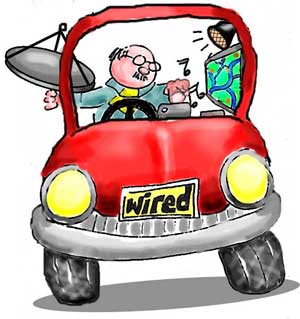Car infotainment systems - are we finally on the right road?
By: Lisa Keegan
Date: 2010-03-14

Today's vehicle is expected to go a lot further than transport it's owner from A to B. We expect our cars to provide the same connectivity as our home or work environment - internet browsing, multimedia playback, speech recognition capabilities to enable in-car calls to mention but a few!
All of this seems pointless if the systems we invest in cannot be updated as soon as a new feature becomes available, but this has so far been the case. With the exception of satellite navigation devices, most in-car infotainment systems remain static from the day they are installed.
The recent debacle over stuck gas pedals at Toyota resulted in affected vehicles being recalled for a software update to remedy the problem. These software updates seem standard for many aspects of vehicle operation but are strangely lacking when it comes to in-car infotainment systems. That is, until now.
In his recent post on edmunds.com, Doug Newcomb describes Ford's popular Sync system which, developed in conjunction with Microsoft, provides all the infotainment standards and more, but what is significant about Sync is that it is a software-based system and can therefore be easily updated.
Collaboration between Microsoft and car manufacturers is nothing new. There have been past collaborations between Microsoft and Fiat and Microsoft and Kia but, apart from user interface and GPS integration updates, these in-car systems have developed little in the past few years. These systems have lacked two essential features which have been addressed by Ford Sync - the ability to update the software and the ability to integrate third party applications. Sync enables the integration of outside applications like Pandora and Stitcher for Internet radio and OpenBeak for Twitter.
Seattlepi.com asks a crucial question in all of this 'why, when the smartphone industry has sparked an explosion of the third-party app market, has this growth been slow when it comes to in-car systems?'. The answer they give is safety.
Third party apps for in-car systems must work seamlessly and help minimise any distraction to the driver. Driver distraction and safety issues will be key in the development of these systems.
Prior to the Sync system, if I bought a new iphone and it didn't integrate well with my car, I would have two choices - change my phone or change my car. Now there is a third, eminently more sensible choice, update the car software to enable integration of my new phone.
Doug Newcomb explains how this very situation was addressed with ford Sync - 'Our Director of Vehicle Testing Dan Edmunds found how easy it was to update the Sync system in our long-term Ford Flex when he got an iPhone 3GS. Upgrading Sync to work with Dan's new iPhone was just a download away.'
Sync will become standard in many of Ford's models and will force the industry to follow suit. We consumers are becoming more and more demanding, particularly when it comes to our electronics and devices. In these competitive and difficult times for the car industry, information and innovation are key, and nothing turns a consumer away faster than the word 'obsolete'.
Comments to this article have been disabled.
